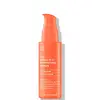What's inside
What's inside
 Key Ingredients
Key Ingredients

 Benefits
Benefits

 Concerns
Concerns

No concerns
 Ingredients Side-by-side
Ingredients Side-by-side

Water
Skin Conditioning3-O-Ethyl Ascorbic Acid
Skin ConditioningTetrahexyldecyl Ascorbate
AntioxidantPropanediol
SolventCoconut Alkanes
EmollientPolyester-4
Skin ConditioningDimethicone
EmollientGlycerin
HumectantEthylhexyl Olivate
Skin ConditioningGlyceryl Caprylate
EmollientAscorbic Acid
AntioxidantGlutathione
Gold
Cosmetic ColorantSodium Acrylates Copolymer
Coco-Caprylate/Caprate
EmollientPolyglyceryl-4 Oleate
EmulsifyingAmmonium Acryloyldimethyltaurate/Vp Copolymer
Butylene Glycol
HumectantPolysilicone-11
Citric Acid
BufferingButyrospermum Parkii Butter
Skin ConditioningCaprylhydroxamic Acid
Sorbitol
HumectantTerminalia Ferdinandiana Fruit Extract
AntioxidantAlteromonas Ferment Extract
Skin ConditioningAnnona Muricata Fruit Extract
Skin ConditioningEuterpe Oleracea Fruit Extract
Hylocereus Undatus Fruit Extract
Skin ConditioningMangifera Indica Fruit Extract
Skin ConditioningPersea Gratissima Fruit Extract
EmollientPrunus Domestica Fruit Extract
MoisturisingPsidium Guajava Fruit Extract
AstringentTamarindus Indica Extract
SmoothingCaprylyl Glycol
EmollientDecyl Glucoside
Cleansing1,2-Hexanediol
Skin ConditioningXanthan Gum
EmulsifyingHexylene Glycol
EmulsifyingPhenoxyethanol
PreservativeWater, 3-O-Ethyl Ascorbic Acid, Tetrahexyldecyl Ascorbate, Propanediol, Coconut Alkanes, Polyester-4, Dimethicone, Glycerin, Ethylhexyl Olivate, Glyceryl Caprylate, Ascorbic Acid, Glutathione, Gold, Sodium Acrylates Copolymer, Coco-Caprylate/Caprate, Polyglyceryl-4 Oleate, Ammonium Acryloyldimethyltaurate/Vp Copolymer, Butylene Glycol, Polysilicone-11, Citric Acid, Butyrospermum Parkii Butter, Caprylhydroxamic Acid, Sorbitol, Terminalia Ferdinandiana Fruit Extract, Alteromonas Ferment Extract, Annona Muricata Fruit Extract, Euterpe Oleracea Fruit Extract, Hylocereus Undatus Fruit Extract, Mangifera Indica Fruit Extract, Persea Gratissima Fruit Extract, Prunus Domestica Fruit Extract, Psidium Guajava Fruit Extract, Tamarindus Indica Extract, Caprylyl Glycol, Decyl Glucoside, 1,2-Hexanediol, Xanthan Gum, Hexylene Glycol, Phenoxyethanol
Alternatives
Ingredients Explained
These ingredients are found in both products.
Ingredients higher up in an ingredient list are typically present in a larger amount.
You might know this ingredient as Ethyl Ascorbic Acid, a more stable version of ascorbic acid.
Like other types of vitamin C, this ingredient has many benefits including reducing wrinkles, skin soothing, dark spot fading, and fighting against free radicals.
3-O-Ethyl Ascorbic Acid interferes with the process of skin darkening, helping to reduce hyperpigmentation. It also encourages the skin to produce more collagen.
Once applied, 3-O-Ethyl Ascorbic Acid is converted to Vitamin C deeper in the skin's layers. This process is slow but makes this ingredient more tolerable for skin.
The optimum pH range for this ingredient is 4 - 5.5
Learn more about 3-O-Ethyl Ascorbic AcidCaprylyl Glycol is a humectant and emollient, meaning it attracts and preserves moisture.
It is a common ingredient in many products, especially those designed to hydrate skin. The primary benefits are retaining moisture, skin softening, and promoting a healthy skin barrier.
Though Caprylyl Glycol is an alcohol derived from fatty acids, it is not the kind that can dry out skin.
This ingredient is also used as a preservative to extend the life of products. It has slight antimicrobial properties.
Learn more about Caprylyl GlycolGlutathione is an antioxidant naturally found in our bodies. It is made up of three amino acids: glycine, cysteine, and glutamic acid.
As an antioxidant, it prevents oxidative damage to parts of our cell.
While glutathione is said to help with fading dark spots, the results from research are inconclusive. Further studies are needed. With that said, gluthatione has been shown to protect our skin from UV-B induced damage.
This ingredient is naturally occurring in plants, animals, fungi, and some bacteria.
Learn more about GlutathionePhenoxyethanol is a preservative that has germicide, antimicrobial, and aromatic properties. Studies show that phenoxyethanol can prevent microbial growth. By itself, it has a scent that is similar to that of a rose.
It's often used in formulations along with Caprylyl Glycol to preserve the shelf life of products.
Tetrahexyldecyl Ascorbate (THD) is a stable and oil-soluble form of Vitamin C.
THD is special in that it has the ability to travel deeper into skin than traditional ascorbic acid while maintaining the same skin benefits (double win!).
Because it’s oil-soluble, THD dives deep into your skin’s fatty layers (think ceramides and cholesterol) to fight off the kind of free radicals that mess with your skin barrier. This makes it a great pair with water-based vitamin C (ascorbic acid) that mainly works on the surface.
Even at just 0.1%, THD is already showing great antioxidant activity. When used up to 2%, it helps keep your skin happy and calm, especially when it’s stressed from pollution or sun.
Want to fade dark spots or tackle hyperpigmentation? You’ll want 5% or more. Pairing it with brightening buddies like niacinamide or licorice root gives even better results. One study even used 30% THD with other brighteners and saw real results on stubborn discoloration, even in melasma-prone skin.
A note on THD: It’s has a slightly silky, oily texture and usually shows up colorless or pale yellow (though the exact shade can vary by supplier).
While you can sneak it into water-based formulas, it really shines when paired with silicones or oils, which help your skin soak it up better.
THD is pretty stable, but it’s still vulnerable to degradation like ascorbic acid. Too much light or heat (above 113°F / 45°C) can break it down over time. Go for dark and opaque packaging that keeps it safe and shady!
Read more about other types of Vitamin C:
Learn more about Tetrahexyldecyl Ascorbate